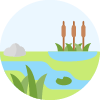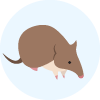On this page:
The MSA Program is one of Victoria’s largest urban conservation programs, set to secure more than 20,000 hectares of much needed habitat for some of our rarest plants, animals and ecosystems.
Creating these conservation areas and reserves will protect nature, preserve cultural heritage, landscape and values, and open up more opportunities for people to connect with nature, right next door to some of our newest neighbourhoods.
Take a look at some of our highlights.
Western Grassland Reserve update
Land acquisition
 So far, we've purchased approximately 26% of the Western Grassland Reserve. This means 3,854 hectares of threatened grasslands and wetlands are permanently protected. This land is currently being restored and managed by Parks Victoria. As we continue to raise revenue from the MSA Levy, we will purchase more land.
So far, we've purchased approximately 26% of the Western Grassland Reserve. This means 3,854 hectares of threatened grasslands and wetlands are permanently protected. This land is currently being restored and managed by Parks Victoria. As we continue to raise revenue from the MSA Levy, we will purchase more land.
Managing weeds and other threats
Weeds are one of the most serious threats to fragile grassland ecosystems. Serrated tussock are found in many parts of the reserve and are considered to be one of the most damaging weeds in Australia because of their ability to quickly spread and invade pastures and grasslands.
Controlling and managing weeds is a complex task, with each area requiring different methods of removal. To do this, we work with various organisations, local councils, and other government agencies to manage threats to native plants, animals, and ecosystems.
Our delivery partner, Wyndham City Council, has completed vegetation surveys and weed control on more than 7,000 hectares of land.
Creating new conservation areas
 The growling grass frog, golden sun moth, and striped legless lizard are some of the threatened species that will be permanently protected in 36 conservation areas across more than 5,000 hectares around Melbourne. So far, we have secured land in 17 conservation areas. This includes Banda Bail, in Melbourne’s north.
The growling grass frog, golden sun moth, and striped legless lizard are some of the threatened species that will be permanently protected in 36 conservation areas across more than 5,000 hectares around Melbourne. So far, we have secured land in 17 conservation areas. This includes Banda Bail, in Melbourne’s north.
Protecting rare woodland
 Through our partnership with Wurundjeri Woi-Wurrung Cultural Heritage Aboriginal Corporation, and Trust for Nature, we are creating the 1,200-hectare Grassy Eucalypt Woodland Protected Area in Melbourne’s north west.
Through our partnership with Wurundjeri Woi-Wurrung Cultural Heritage Aboriginal Corporation, and Trust for Nature, we are creating the 1,200-hectare Grassy Eucalypt Woodland Protected Area in Melbourne’s north west.
Trust for Nature leads the landowner engagement and Wurundjeri is surveying properties to identify priorities.
Growling grass frog program
 Habitat loss, a deadly fungus and predatory fish are some of the reasons growling grass frog numbers have dropped by around 50%, according to our recent monitoring study of nearly 150 sites in Merri Creek and Darebin Creek.
Habitat loss, a deadly fungus and predatory fish are some of the reasons growling grass frog numbers have dropped by around 50%, according to our recent monitoring study of nearly 150 sites in Merri Creek and Darebin Creek.
Through this program, we've secured land in growling grass frog conservation areas 34 (Merri Creek) and 36 (Clyde Creek). We've also completed a purpose-built growling grass frog wetland near Rockbank where these frogs are now thriving.
Planning is progressing for 19 more wetlands (in the Merri Creek, Kororoit Creek and Cardinia Creek conservation areas), to be delivered by Melbourne Water.
Getting on the bandi-wagon
 We’re proud to partner with Royal Botanic Gardens Cranbourne (RBGC) to support and encourage local councils, developers and communities to create bandicoot-friendly suburbs in the south-east.
We’re proud to partner with Royal Botanic Gardens Cranbourne (RBGC) to support and encourage local councils, developers and communities to create bandicoot-friendly suburbs in the south-east.
The southern brown bandicoot program helps wildlife live side-by-side with us and residents to connect with and value nature. Work has begun establishing habitat corridors to help bandicoots safely navigate residential areas.
We are also helping to improve scientific understanding of the bandicoot by contributing to the development of a state-wide genetic rescue strategy to help address the problems associated with the fragmented distribution of Victoria’s populations. In addition, a Population Viability Analysis model is under development to identify knowledge gaps for future research.
Investment in conservation
 We’ve spent more than $227.440 million on land acquisition. This includes:
We’ve spent more than $227.440 million on land acquisition. This includes:
- $162.101 million on land purchases
- $65.339 million on land compensation payments.
$88.826 million has also been spent on land management, monitoring, research and other conservation actions (as of 30 June 2025).
Page last updated: 30/07/25
